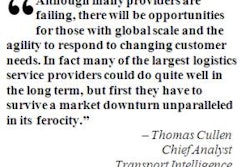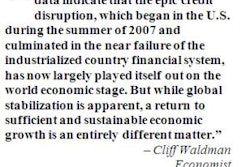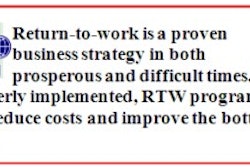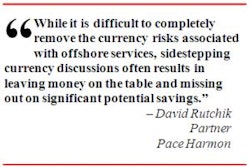There was a time when you could buy buggy whips. You could also depend on the same print supplier to produce a project time after time after time. The print supplier was the buyer's friend, confidante and fishing, hunting or golfing buddy. The sour economy made obsolete those relationships.
Then the U.S. Postal Service increased its bulk shipping rates. This rate increase was so extravagant that the bottom fell out of the direct mail business. Direct mail that was 51 percent of all of the print produced in the United States died. The impact was and is catastrophic. It changed the song to which the relationship buyer and its print supplier danced.
Here's how and why. Printers are customized manufacturers that are busy 70 percent of the time with average 2.3 percent profitability. Drop 25 percent or so out of the market through a sour economy coupled with direct mail decimation and that 70 percent drops like a rock — and so does profitability and the lack thereof. The only thing that goes up is bankruptcies.
Print suppliers are dying like flies. This leaves relationship buyers in the lurch, hanging out to dry. With a limited supplier pool or no supplier pool at all, relationship buyers are being caught with nowhere to go, no safe and proven supplier pool, and no backup plan.
Think what happens now. Where does a relationship buyer that was dependent on a single printer or a handful of suppliers turn to get the work done? Of course, every printer still breathing will want this work, but just as before, not every printer is capable of doing it, and not every printer is as good as its word (believe it or not). The buyer has to learn how to ride the bike all over again, and this is both risky and costly, and may lead to serious problems in supply chain coordination, quality and delivery.
Sad as it may be, before disaster strikes, every buyer needs to take the appropriate steps to protect its own organization and its own interests. The buyer must institute a more dependable, efficient, transparent and cost effective way of ensuring the print supply, regardless of promises made and financial security assurances given.
Here is a safe, proven and recommended series of steps to ensure continuity of service and print supply.
Create a pre-qualified supplier pool in which all suppliers are uniformly evaluated. Yes, that means adding new suppliers, and, no, that does not mean getting rid of existing suppliers. The idea is to expand the supplier pool with vendors that are objectively qualified. Of course, all suppliers — existing and new alike — must be thoroughly reviewed and capable of meeting 100 percent of the project specifications and requirements, 100 percent of the time. Now when printers close their doors, others with whom the buyer is familiar and comfortable are ready to be of service.
Create thorough bid specifications with full details so that changes are avoided later. This allows suppliers to price accurately and best determine when there will be a production opening for producing the job.
Create a fair bidding environment in which the computer matches buyer project specifications only with suppliers capable of doing the work. With detailed project and supplier data, the computer will automatically match each project up for bid with only those suppliers with matching capabilities. This levels the playing field.
Create efficiencies to save time and money. Since critical data already are in the computer, the buying organization does not have to "reinvent the wheel" each time it wants to put a project out for bid.
Create mutual acceptance of the process, whereby every supplier in the pool knows that it can bid low on any project without setting pricing precedent for the next project. The suppliers with open production time to fill and a resulting low price will vary from project to project.
Award bids in a timely manner so the winning supplier will hold a production slot for the project, schedule staff, prepare equipment, order materials and make other preparations required to do the work. Suppliers learn that performance is required to receive opportunities, while price is the criteria to win projects.
Establish full transparency by sending bid results to all suppliers that submitted a bid. This not only creates greater credibility for the buyer among suppliers, it also promotes improved competition.
Monitor every step of the workflow process to ensure clear communications, attention to every detail and a deliverable end product. This must begin with the conceptualization of the project and continue through edits, changes, reporting, production, packaging and delivery.
Ensure that work is performed per specifications and on time. By establishing full accountability, the buying organization is protecting itself against delays that could cause artificial pricing hedges in future bids from the winning supplier.
Complete the project with accurate invoicing. By making sure the invoice is complete, correct, agreed upon and reconciled, both the supplier and the buyer successfully end the project.
These recommended best practices work to protect buyers in a financially unstable marketplace while ensuring that work is not disrupted. Additionally, this approach improves risk management, quality control, workflow communication and transparency.
About the Author: William Gindlesperger is a nationally recognized entrepreneur, inventor, author and consultant in print and procurement. He founded ABC Advisors and its successor, e-LYNXX Corporation, in 1975, and currently he serves as chairman and CEO of e-LYNXX Corporation. Gindlesperger is highly regarded for his knowledge, advice and work on behalf of firms in matters pertaining to the U. S. Government Printing Office (GPO). He was founder and the first chairman of Printing Industries of America's (PIA) PrintPAC (political action committee), and he has been recognized for his contributions to PIA and services to the printing industry. In addition, Gindlesperger has been granted two separate business method patents by the U. S. Patent Office, first for the competitive procurement of print and then for the competitive procurement of all specification-defined goods and services. More information on e-LYNXX Corporation at www.e-LYNXX.com.
Then the U.S. Postal Service increased its bulk shipping rates. This rate increase was so extravagant that the bottom fell out of the direct mail business. Direct mail that was 51 percent of all of the print produced in the United States died. The impact was and is catastrophic. It changed the song to which the relationship buyer and its print supplier danced.
Here's how and why. Printers are customized manufacturers that are busy 70 percent of the time with average 2.3 percent profitability. Drop 25 percent or so out of the market through a sour economy coupled with direct mail decimation and that 70 percent drops like a rock — and so does profitability and the lack thereof. The only thing that goes up is bankruptcies.
Print suppliers are dying like flies. This leaves relationship buyers in the lurch, hanging out to dry. With a limited supplier pool or no supplier pool at all, relationship buyers are being caught with nowhere to go, no safe and proven supplier pool, and no backup plan.
Think what happens now. Where does a relationship buyer that was dependent on a single printer or a handful of suppliers turn to get the work done? Of course, every printer still breathing will want this work, but just as before, not every printer is capable of doing it, and not every printer is as good as its word (believe it or not). The buyer has to learn how to ride the bike all over again, and this is both risky and costly, and may lead to serious problems in supply chain coordination, quality and delivery.
Sad as it may be, before disaster strikes, every buyer needs to take the appropriate steps to protect its own organization and its own interests. The buyer must institute a more dependable, efficient, transparent and cost effective way of ensuring the print supply, regardless of promises made and financial security assurances given.
Here is a safe, proven and recommended series of steps to ensure continuity of service and print supply.
Create a pre-qualified supplier pool in which all suppliers are uniformly evaluated. Yes, that means adding new suppliers, and, no, that does not mean getting rid of existing suppliers. The idea is to expand the supplier pool with vendors that are objectively qualified. Of course, all suppliers — existing and new alike — must be thoroughly reviewed and capable of meeting 100 percent of the project specifications and requirements, 100 percent of the time. Now when printers close their doors, others with whom the buyer is familiar and comfortable are ready to be of service.
Create thorough bid specifications with full details so that changes are avoided later. This allows suppliers to price accurately and best determine when there will be a production opening for producing the job.
Create a fair bidding environment in which the computer matches buyer project specifications only with suppliers capable of doing the work. With detailed project and supplier data, the computer will automatically match each project up for bid with only those suppliers with matching capabilities. This levels the playing field.
Create efficiencies to save time and money. Since critical data already are in the computer, the buying organization does not have to "reinvent the wheel" each time it wants to put a project out for bid.
Create mutual acceptance of the process, whereby every supplier in the pool knows that it can bid low on any project without setting pricing precedent for the next project. The suppliers with open production time to fill and a resulting low price will vary from project to project.
Award bids in a timely manner so the winning supplier will hold a production slot for the project, schedule staff, prepare equipment, order materials and make other preparations required to do the work. Suppliers learn that performance is required to receive opportunities, while price is the criteria to win projects.
Establish full transparency by sending bid results to all suppliers that submitted a bid. This not only creates greater credibility for the buyer among suppliers, it also promotes improved competition.
Monitor every step of the workflow process to ensure clear communications, attention to every detail and a deliverable end product. This must begin with the conceptualization of the project and continue through edits, changes, reporting, production, packaging and delivery.
Ensure that work is performed per specifications and on time. By establishing full accountability, the buying organization is protecting itself against delays that could cause artificial pricing hedges in future bids from the winning supplier.
Complete the project with accurate invoicing. By making sure the invoice is complete, correct, agreed upon and reconciled, both the supplier and the buyer successfully end the project.
These recommended best practices work to protect buyers in a financially unstable marketplace while ensuring that work is not disrupted. Additionally, this approach improves risk management, quality control, workflow communication and transparency.
About the Author: William Gindlesperger is a nationally recognized entrepreneur, inventor, author and consultant in print and procurement. He founded ABC Advisors and its successor, e-LYNXX Corporation, in 1975, and currently he serves as chairman and CEO of e-LYNXX Corporation. Gindlesperger is highly regarded for his knowledge, advice and work on behalf of firms in matters pertaining to the U. S. Government Printing Office (GPO). He was founder and the first chairman of Printing Industries of America's (PIA) PrintPAC (political action committee), and he has been recognized for his contributions to PIA and services to the printing industry. In addition, Gindlesperger has been granted two separate business method patents by the U. S. Patent Office, first for the competitive procurement of print and then for the competitive procurement of all specification-defined goods and services. More information on e-LYNXX Corporation at www.e-LYNXX.com.

















